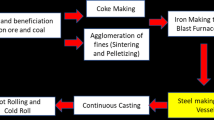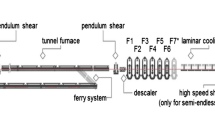Abstract
In the present incident, one of the rollers of grinding mill in cement plant failed during operation, exhibiting longitudinal cracking over inner surface. Deposition welding was carried out just before the incident to match the worn-out profile of the roller. Investigation revealed that the subsurface of the cracked region contained discontinuities like blow holes (≤1.0 mm) and fine cracks (0.2–2.0 mm length). Chemical analysis of the alloy showed low nickel (0.5 wt.%) and high tungsten (~1.0 wt.%) concentration. The deviation in composition reduced the ductility of the component. Microstructure of the alloy consisted of complex carbides (50–200 μm) embedded in martensite–austenite matrix. Under cyclic loading, the fatigue crack was initiated from subsurface containing discontinuities and bulky carbides. Low toughness (~2 J) and high residual tensile stress (~170 Mpa) of the material facilitated crack propagation through thickness direction. Final failure of the component occurred due to overload.







Similar content being viewed by others
References
E. Amrina, M. Oktaviani, Potential failure modes of cement production process: a case study. Proceedings of the International Manufacturing Engineering Conference and the Asia Pacific Conference on Manufacturing Systems, Springer: Singapore pp 205–210, 2019
Grinding plate wear failure analysis, ASM failure analysis case histories: machine tools and manufacturing equipment. SM Int. https://doi.org/10.31399/asm.fach.machtools.9781627082235 2019
M.D.M. Neves, A.H.P. Andrade, D.N. Silva, Analysis of the criticality of flaws found in trunnion of grinding ball mills used in mining plants. Engg. Failure Ana. 61, 28–36 (2016)
R.S. Sinha, A.K. Mukhopadhyay, Failure rate analysis of Jaw Crusher: a case study. Sådhanå. 44(17), 1–9 (2019). https://doi.org/10.1007/s12046-018-1026-4
R. Eshghian, M. Abbasi, Wear and failure analysis of semi-autogenous grinding mill liners. J. Failure Ana. Prevention. 17(2), 340–348 (2017). https://doi.org/10.1007/s11668-017-0249-8
S.S. Ngiam, F.P. Brennan, Fatigue crack control in structural details using surface peening. J. Ship Prod. 24(3), 147–151 (2008)
C.R.S. Da Silva, M. Boccalini, Thermal cracking of multicomponent white cast iron. Mats. Sci. Technol. 21(5), 565–573 (2005)
H. Mohebbi, D.A. Jesson, M.J. Mulheron, P.A. Smith, Characterisation of the fatigue properties of cast irons used in the water industry and the effect on pipe strength and performance. J. Phys. Conf. Ser. 181, 012039 (2009). https://doi.org/10.1088/1742-6596/181/1/012039
H. Farhangi, S. Norouzi, M. Nili-Ahmadabadi, Effects of casting process variables on the residual stress in Ni-base super alloys. J. Mats. Proc. Technol. 153–154, 209–212 (2004)
A.A. Keste, S.H. Gawande, C. Sarkar, Design optimization of precession casting for residual stress reduction. J. Comp. Des. Eng. 3(2), 140–150 (2016)
X.R. Chen, Q.J. Zhai, H. Dong, B.H. Dai, H. Mohrbacher, Molybdenum alloying in cast iron and steel. Adv. Manuf. 8, 3–14 (2020)
A.N. Sudhakar, R. Markandeya, R.B. Srinivasa, A.K. Pandey, D. Kaushik, Effect of alloying elements on the microstructure and mechanical properties of high chromium white cast iron and Ni-hard iron. Mats. Today Proceed. 61(3), 1006–1014 (2022)
E. Cortes-Carrillo, A. Bedolla-Jacuinde, I. Mejia, C.M. Zepeda, J. Zuno-Silva, F.V. Guerra-Lopez, Effects of tungsten on microstructure and on the abrasive wear behaviour of a high chromium white cast iron. Wear. 376–377, 77–85 (2017)
D. Myszka, J. Kasinska, A. Penkul, Influence of tungsten on the structure and properties of ductile iron containing 0.8% Cu. Arch. Foundry Eng. 21(4), 121–126 (2021). https://doi.org/10.24425/afe.2021.139760
Z. Zhao, Y. Cao, X. Wan, J. Li, G. Li, Effect of cooling rate on carbide characteristics of high vanadium high speed steel. ISIJ Int. 62(3), 524–531 (2022)
A.K. Syed, B. Ahmad, H. Guo, T. Machry, D. Eatock, J. Meyer, M.E. Fitzpatrick, X. Zhang, An experimental study of residual stress and direction-dependence of fatigue crack growth behaviour in as-built and stress relieved selective-laser-melted Ti6Al4V. Mats. Sci. Engg. A. 755, 246–257 (2019)
A. Trudel, M. Brochu, M. Levesque, Residual stress effects on the propagation of fatigue crack in the weld of a CA6NM stainless steel, 13th International Conference on Fracture. Beijing, China 2013
A. Jameel, G.A. Harmain, Fatigue crack growth in presence of material discontinuities by EFGM. Int. J. Fatigue. 81, 105–116 (2015)
Y. Liu, S. Liu, Optimization design of unbonded areas layout in Titanium alloy laminates for fatigue performance. Symmetry. 14, 1836 (2022). https://doi.org/10.3390/sym14091836
R.O. Ritchie, Mechanisms of fatigue crack propagation in ductile and brittle solids. Int. J. Fract. 100, 55–83 (1999)
Acknowledgment
Authors are grateful to Director, CSIR-NML, for providing the infrastructural support to carry out the investigation and accord permission to publish the work.
Author information
Authors and Affiliations
Corresponding author
Additional information
Publisher's Note
Springer Nature remains neutral with regard to jurisdictional claims in published maps and institutional affiliations.
Rights and permissions
Springer Nature or its licensor (e.g. a society or other partner) holds exclusive rights to this article under a publishing agreement with the author(s) or other rightsholder(s); author self-archiving of the accepted manuscript version of this article is solely governed by the terms of such publishing agreement and applicable law.
About this article
Cite this article
Ghosh, M., Mahato, B. & Kumar, B.R. Operational Failure of Vertical Roller Attached to a Grinding Mill: Root Cause Analysis. J Fail. Anal. and Preven. 23, 2322–2330 (2023). https://doi.org/10.1007/s11668-023-01818-1
Received:
Accepted:
Published:
Issue Date:
DOI: https://doi.org/10.1007/s11668-023-01818-1




